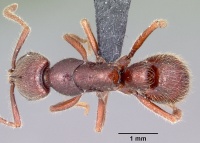Euponera zoro
| Euponera zoro | |
|---|---|

| |
| Scientific classification | |
| Kingdom: | Animalia |
| Phylum: | Arthropoda |
| Class: | Insecta |
| Order: | Hymenoptera |
| Family: | Formicidae |
| Subfamily: | Ponerinae |
| Tribe: | Ponerini |
| Genus: | Euponera |
| Species complex: | sikorae |
| Species: | E. zoro |
| Binomial name | |
| Euponera zoro (Rakotonirina & Fisher, 2013) | |
Collected via leaf litter extraction in Marojejy, and from malaise traps in Ambalagoavy.
Identification
Rakotonirina and Fisher (2013) - Worker. Anterior margin of clypeus medially convex or with median obtuse angle; with head in full-face view, lateral margins before level of anterior margin of eye strongly converging toward the base of mandibles; anterior surface of third abdominal segment straight, without shallow cavity. Posterolateral margins of propodeum and petiole node without succession of sharp teeth or denticles, posterior margin of propodeum bordered with subopaque lamella; in dorsal view, petiole node nearly as long as broad; in lateral view, subpetiolar process with anterior hook-like and posterior subtriangular processes separated by a concavity.
Keys including this Species
Distribution
Euponera zoro occupies the lowland rainforests of Marojejy and Ambalagoavy Nord (Ikongo) located in the northeast and southeast of Madagascar respectively.
Latitudinal Distribution Pattern
Latitudinal Range: -14.4367° to -21.8275°.
| North Temperate |
North Subtropical |
Tropical | South Subtropical |
South Temperate |
- Source: AntMaps
Distribution based on Regional Taxon Lists
Malagasy Region: Madagascar (type locality).
Distribution based on AntMaps
Distribution based on AntWeb specimens
Check data from AntWeb
Countries Occupied
| Number of countries occupied by this species based on AntWiki Regional Taxon Lists. In general, fewer countries occupied indicates a narrower range, while more countries indicates a more widespread species. |

|
Estimated Abundance
| Relative abundance based on number of AntMaps records per species (this species within the purple bar). Fewer records (to the left) indicates a less abundant/encountered species while more records (to the right) indicates more abundant/encountered species. |

|
Biology
Castes
Images from AntWeb
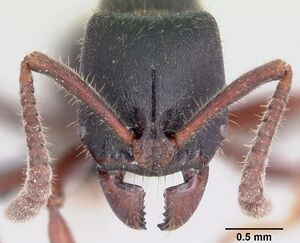   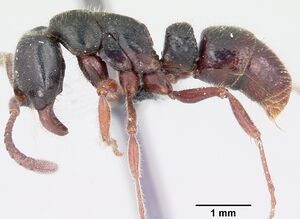   
| |
| Worker. Specimen code casent0045619. Photographer April Nobile, uploaded by California Academy of Sciences. | Owned by CAS, San Francisco, CA, USA. |
 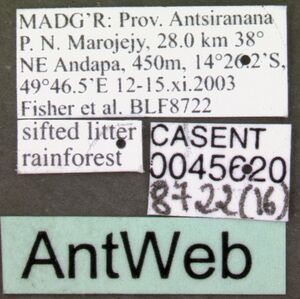 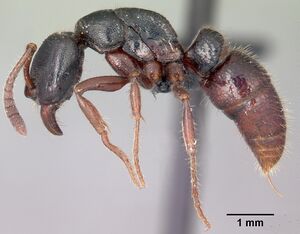  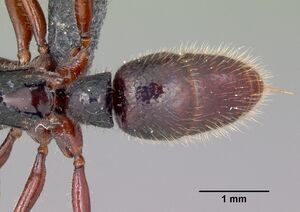  
| |
| Worker. Specimen code casent0045620. Photographer Jean Claude Rakotonirina, uploaded by California Academy of Sciences. | Owned by CAS, San Francisco, CA, USA. |
Nomenclature
The following information is derived from Barry Bolton's Online Catalogue of the Ants of the World.
- zoro. Pachycondyla zoro Rakotonirina & Fisher, 2013: 480, figs. 21, 22, 67, 68, 69, 81 (w. ergatoid q.) MADAGASCAR. Combination in Euponera: Schmidt & Shattuck, 2014: 87.
Unless otherwise noted the text for the remainder of this section is reported from the publication that includes the original description.
Description
Worker
(8 specimens): HW: 1.22–1.32, HL: 1.33–1.46, CI: 90–94, SL: 1.11–1.17, SI: 87–92, PW: 0.95–1.02, WL: 1.85–2.05, NH: 0.77–0.83, NL: 0.53–0.61, NW: 0.67–0.73, DNI: 115–136, LNI: 135–154.
In full-face view, head subrectangular; longer than broad, with almost straight lateral margins posterior to the level of eye. Anterior to the level of eye, lateral margin curves strongly toward the base of mandibles; posterior margin weakly concave. Frontal lobe narrow, with broadly rounded outer margin. Head dorsally finely reticulate-punctate, with smooth and shiny surface between punctures; side smooth and shiny apart from effaced reticulation and shallow scattered punctures. Eyes medium, their diameter about the same as greatest width of scape. Antennal scape barely extending beyond posterior cephalic margin. Median lobe of clypeus weakly protruding forwards, anterior margin medially convex and sometimes with feeble median notch. Mandible smooth between sparse piligerous punctulae, masticatory margin with 9–12 teeth or denticles.
In dorsal view, metanotal groove obsolete; promesonotum rugulose-punctate with smooth and shiny surface towards midline of mesosoma; propodeal dorsum sparsely punctate. In lateral view, mesopleural suture indistinct, median portion of mesopleuron and metapleuron shining and nearly smooth apart from widely spaced punctures or foveolae, with rugulose sculpture near lateroventral angle; sides of propodeum covered with dense, elongate punctures; posterolateral margin of propodeum bordered with subopaque lamellae. Petiole node in lateral view higher than long, with rugulose surface; anterodorsal angle extending somewhat over anterior face; posterior margin convex; subpetiole with both anterior hook-like and posterior subquadrate processes separated by a concavity. In dorsal view, node as long as broad, with nearly smooth dorsum apart from scattered rugulae and shallow punctures. Shallow cavity absent from anterior surface of first gastral segment. First and second gastral tergites with spaced punctures from which erect hairs arise.
Pilosity consists of golden short erect hairs and abundant pubescence on head and promesonotum; rest of body dorsum with long erect hairs and very little pubescence. Head, mesosoma and petiolar node black; appendages and gaster brown ferruginous.
Queen
Ergatoid. (1 specimen): HW: 1.25, HL: 1.28, CI: 98, SL: 1.08, SI: 86, PW: 0.99, WL: 1.91, NH: 0.81, NL: 0.51, NW: 0.79, DNI: 155, LNI: 159. This specimen is very similar to workers due to the absence of wings and thoracic sclerite development. It differs by the presence of one ocellus, the broader head and much more slender and numerous erect hairs on the dorsum of the body. In addition, the petiolar node looks shorter when viewed in profile and much broader than those of workers when in dorsal view.
Type Material
Holotype worker: Antsiranana, Parc National de Marojejy, Manantenina River, 28.0 km 38° NE Andapa, 8.2 km 333° NNW Manantenina, -14.4367, 49.775, 450 m, sifted litter (leaf mold, rotten wood), rainforest, 12–15 Nov 2003 (coll. B.L. Fisher et al.), collection code BLF08722, specimen code CASENT0045620 (California Academy of Sciences). Paratypes: series of seven workers and one ergatoid queen with same data as holotype but specimens coded as CASENT0045613, CASENT0045615, CASENT0045616, CASENT0045618, CASENT0045619, CASENT0045623, CASENT0045627, CASENT0045614 (The Natural History Museum, CASC, Musee d'Histoire Naturelle Genève, Museum of Comparative Zoology, Parc Botanique et Zoologique de Tsimbazaza).
References
- Rakotonirina, J.C. & Fisher, B.L. 2013. Revision of the Pachycondyla sikorae species-group (Hymenoptera: Formicidae) in Madagascar. Zootaxa 3683, 447-485.
- Schmidt, C.A. & Shattuck, S.O. 2014. The higher classification of the ant subfamily Ponerinae (Hymenoptera: Formicidae), with a review of ponerine ecology and behavior. Zootaxa 3817, 1–242 (doi:10.11646/zootaxa.3817.1.1).
References based on Global Ant Biodiversity Informatics
- Rakotonirina J. C., and B. L. Fisher. 2013. Revision of the Pachycondyla sikorae species-group (Hymenoptera: Formicidae) in Madagascar. Zootaxa 3683 (4): 447-485.

